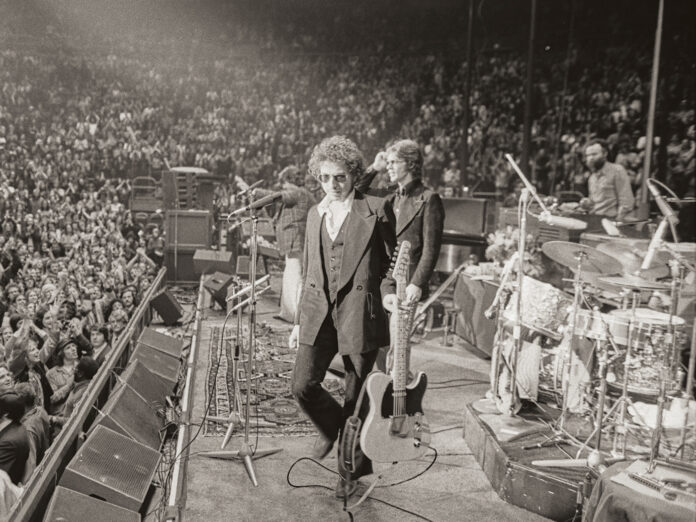In Toronto’s Maple Leaf Stadium on January 9, 1974, Bob Dylan and The Band delivered a concert including a brutally ugly “Lay Lady Lay” and a version of “Like A Rolling Stone” that didn’t so much end as collapse in a heap. Barely a week after making a solid and warmly received start to their reunion tour of 21 US cities, they had arrived in Canada, the birthplace of four members of The Band, and perhaps celebrated the homecoming not wisely but too well. At the next concert, in Montreal two nights later, Dylan was halfway through the first verse of “The Times They Are A-Changin’” when he forgot the words.
In Toronto’s Maple Leaf Stadium on January 9, 1974, Bob Dylan and The Band delivered a concert including a brutally ugly “Lay Lady Lay” and a version of “Like A Rolling Stone” that didn’t so much end as collapse in a heap. Barely a week after making a solid and warmly received start to their reunion tour of 21 US cities, they had arrived in Canada, the birthplace of four members of The Band, and perhaps celebrated the homecoming not wisely but too well. At the next concert, in Montreal two nights later, Dylan was halfway through the first verse of “The Times They Are A-Changin’” when he forgot the words.
At that point the tour’s promoter, the legendary Bill Graham, may have had a quiet word. Those listening to the new 27-disc boxset of soundboard and multitrack recordings from the tour in strict sequence will notice that two nights later, during an afternoon show in Boston, discipline has been restored, particularly in a pin-sharp five-song solo acoustic set featuring exquisite harmonica solos, each number – including “The Times…”, “Don’t Think Twice…” and “Gates Of Eden” – sung in a respectful approximation of the voice used on the original recording.
There’s also a wonderfully subtle “Ballad Of A Thin Man”, a song which, throughout the tour, will have each of its hidden facets turned towards the light. The many versions of that song sprinkled throughout the discs illustrate the fluctuations of interpretation, form and commitment that were a feature of Dylan’s first tour in eight years, unremarked at the time but now on full view.
He had been talked into the project by David Geffen, who had just lured him away from Columbia Records to sign with his Asylum label. Planet Waves gave Geffen something to promote as Dylan and The Band embarked on one of the first real arena tours, playing to 650,000 people at 40 concerts in 21 cities across five and a half weeks.
At the time, now the ’60s were over and a new decade had begun, it was hard to get a clear idea of exactly who Dylan currently was. The disconcerting kaleidoscope of Self Portrait, the enigmatic retrenchment of New Morning, guest spots in studios with Doug Sahm, Steve Goodman and Bette Midler and in charity concerts for Chile and Bangla Desh, a trip to Israel and domestic relocation to Malibu, a couple of random singles and his participation in Pat Garrett & Billy The Kid – all of it had blurred his outline. After he’d stepped up to play harmonica with John Prine at the Bitter End in 1972, Prine remarked: “No-one believed it. They thought Bob Dylan was either dead or on Mount Fuji.”
So the tour amounted to a relaunch. With Planet Waves giving him his first ever No 1 album in the US, the setlist featured a handful of its new songs, including many versions of “Something There Is About You” and “Forever Young” (yet to become an anthem), and occasional airings of “Wedding Song”, “Tough Mama” and “Nobody ’Cept You”, a lightweight love song dropped from the album’s final running order. But the bulk of each concert would consist of pre-loved material in recognisable versions, making it easy for commentators to proclaim his return to form.
The final shows at the LA Forum provided almost all the material for Before The Flood, the double album released four months after the end of the tour, in which equal weight was given to the three elements that made up the concerts – Dylan with the Band, Dylan alone, the Band alone. The new boxset omits all the Band’s numbers, allowing us to concentrate on how Dylan reconciled the decision to present older material with his restless search for new angles.
So we can hear how, on opening night in Chicago, he delivers “The Lonesome Death Of Hattie Carroll” in a way that shrinks a packed sports stadium to the dimensions of a Greenwich Village coffee house. In the first two shows at Madison Square Garden, he and The Band attack the set with a kind of wild exuberance, while staying within the songs’ guardrails. When waywardness threatens to return in the first half of the third show at the Garden, Dylan pulls it together with a magnificent “It’s Alright, Ma…”, although there’s not much he can do when something similar happens in Seattle a week later.
This time around he was giving the people the songs they wanted, mostly played the way they wanted to hear them. When Sara, his then-wife, attended the LA show, she was rewarded with the tour’s sole rendering of “Mr Tambourine Man”, her own favourite, in a full-band arrangement with Garth Hudson’s accordion (and a highlight throughout the box is the wonderful variety of the eight-bar organ solos Garth plays on the many versions of “All Along the Watchtower”).
As a result, there was none of the hostility encountered around the world eight years earlier. Yet this tour, too, would achieve its own historical significance. Whereas 1966 was a journey into the unknown, 1974 was a voyage into well-charted territories that showed him a path he didn’t want to follow: the one that involved playing, as he reflected later, the role of Bob Dylan. Never again would an audience’s expectations take precedence over his own instincts. It’s worth the investment to hear him reaching that career-redefining conclusion, on which so much further controversy would hang.
When you purchase through links on our site, we may earn an affiliate commission. Here’s how it works.



